Emil Decoeur French, 1876-1953
c. 1902
Further images
-
(View a larger image of thumbnail 1
)

-
(View a larger image of thumbnail 2
)
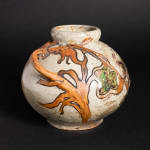
-
(View a larger image of thumbnail 3
)
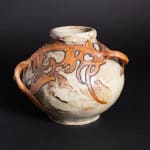
-
(View a larger image of thumbnail 4
)
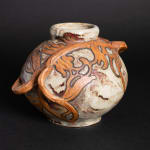
-
(View a larger image of thumbnail 5
)
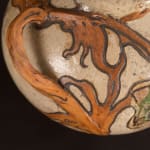
-
(View a larger image of thumbnail 6
)

-
(View a larger image of thumbnail 7
)

-
(View a larger image of thumbnail 8
)

-
(View a larger image of thumbnail 9
)
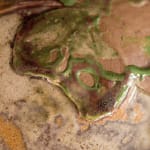
-
(View a larger image of thumbnail 10
)

The finest examples of vases produced in collaboration between Edmond Lachenal and Emile Decoeur date from 1901-1904. This vase, with the word “original” marked on its underside, indicates that the ceramists produced it as a possible model from which other vases could be based. In addition to creating one-of-a-kind ceramic works of art, their workshop remained true to the potter’s trade by designing reproducible objects. Here, the influence of Japonisme is unmistakable. Heavy black outlining creates a spatial illusion in the manner of Japanese ukiyo-e prints. Hand-built ceramic elements grow out of the vase whose tendrils thrust outwards and break the plane into 3-dimensionality. Disappearing at the neck, there is an illusion that the vine has grown right into the glaze. These naturalistically rendered vines, which emanate from their more abstracted rootstock, intertwine and intermingle with the ceramic to heighten the sense that man-made ware is melding with nature to ultimately produce a unified organic form. Akin to the Japanese aesthetic, Decoeur and Lachenal incorporate each technical step as a mark of artistic craftsmanship. Where many ceramists perfunctorily passed off the final production stages as decor, these artists saw glazing as integral to the fully realized art object. Decoeur and Lachenal personally supervised the firing process in order to showcase their creative and technical mastery of the medium. Clay’s malleability is expressed by the twisting terra cotta whose roughness and “unfinished” appearance shows the hand of the artist and one aspect of the process of creation; while clay’s dual characteristic is manifest by the transformative process of firing in the glossy smoothness of the vase’s hardened surface. In much the same way as they commingled formal and symbolic inspirations from Nature, Decoeur and Lachenal delighted in exploring the dualities and contrasts in the medium itself.
Glazed stoneware vase in the art nouveau style, the footed boule shape terminates with a short neck and mouth which are slightly narrower than the foot, the decorative handles are shaped as sinewy vines which flow back into the body and are boldly scored and outlined in black. The beige underglaze reveals ochre and sang-de-boeuf accents that is further enhanced with terra cotta and richly applied green enameled over-glazing; marked under the base: “Original”/Decoeur’s monogram and “Lachenal” with “1151” and “LACHENAL” superimposed in black ink.









